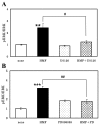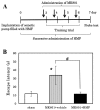Isolation and characterization of activators of ERK/MAPK from citrus plants
- PMID: 22408427
- PMCID: PMC3291996
- DOI: 10.3390/ijms13021832
Isolation and characterization of activators of ERK/MAPK from citrus plants
Abstract
Extracellular signal-regulated kinases 1/2 (ERK1/2), components of the mitogen-activated protein kinase (MAPK) signaling cascade, have been recently shown to be involved in synaptic plasticity and in the development of long-term memory in the central nervous system (CNS). We therefore examined the ability of Citrus compounds to activate ERK1/2 in cultured rat cortical neurons, whose activation might have a protective effect against neurodegenerative neurological disorders. Among the samples tested, extracts prepared from the peels of Citrus grandis (Kawachi bankan) were found to have the greatest ability to activate ERK1/2. The active substances were isolated by chromatographic separation, and one of them was identified to be 3,5,6,7,8,3',4'-heptamethoxyflavone (HMF). HMF significantly induced the phosphorylation of cAMP response element-binding protein (CREB), a downstream target of activated ERK1/2, which appears to be a critical step in the signaling cascade for the structural changes underlying the development of long-term potentiation (LTP). In addition, the administration of HMF into mice treated with NMDA receptor antagonist MK-801 restored the MK-801-induced deterioration of spatial learning performance in the Morris mater-maze task. Taken together, these results suggest that HMF is a neurotrophic agent for treating patients with memory disorders.
Keywords: 3,5,6,7,8,3′,4′-heptamethoxyflavone; Citrus grandis; ERK1/2; Kawachi bankan; MK-801; methoxyflavone; neurons.
Figures







References
-
- Benavente-García O., Castillo J., Martín F.R., Ortuño A., del Rio J.A. Uses and properties of Citrus flavonoids. J. Agric. Food Chem. 1997;45:4505–4515.
-
- Benavente-García O., Castillo J. Update on uses and properties of Citrus flavonoids: New findings in anticancer, cardiovascular, and anti-inflammatory activity. J. Agric. Food Chem. 2008;56:6185–6205. - PubMed
-
- Spencer J.P.E., Vauzour D., Rendeiro C. Flavonoids and cognition: The molecular mechanisms underlying their behavioural effects. Arch. Biochem. Biophys. 2009;492:1–9. - PubMed
-
- Matsuzaki K., Yamakuni T., Hashimoto M., Haque A.M., Shido O., Mimaki Y., Sashida Y., Ohizumi Y. Nobiletin restoring β-amyloid-impaired CREB phosphorylation rescues memory deterioration in Alzheimer’s disease model rats. Neurosci. Lett. 2006;400:230–234. - PubMed
Publication types
MeSH terms
Substances
LinkOut - more resources
Full Text Sources
Miscellaneous

